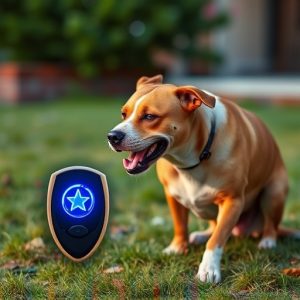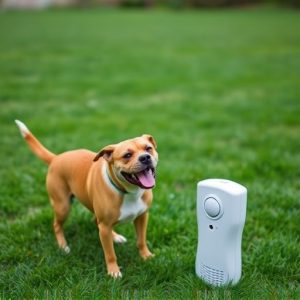Safe Ultrasonic Tools: Modifying Dog Behavior with Frequency
Dogs' behaviors are shaped by instincts and experiences, requiring understanding for effective…….
Dogs' behaviors are shaped by instincts and experiences, requiring understanding for effective modification. Safe ultrasonic frequencies, inaudible to humans but perceptible to dogs, offer a gentle training method. Using specific canine-focused tools, these frequencies can curb unwanted behaviors like barking or jumping through positive/negative reinforcement. For house training and basic obedience, they encourage desired actions with pleasant sounds. Safety is paramount: monitor dog responses, use during supervised sessions, and avoid prolonged solitude while operating ultrasonic frequency devices for responsible, effective dog behavior control.
Introducing the revolutionary tool for dog behavior modification: ultrasonic frequency devices. This article explores how these innovative tools, utilizing safe ultrasonic frequencies for dog control, can transform canine conduct. By delving into the science of dog behavior and the impact of sound waves, we uncover the mechanisms behind effective training. We also emphasize safety considerations, providing expert tips and best practices to ensure positive results while promoting a harmonious relationship between dogs and their owners.
- Understanding Dog Behavior and Ultrasonic Frequencies
- Safety Considerations for Using Ultrasonic Tools on Dogs
- How Ultrasonic Frequency Devices Modify Dog Behavior
- Training Tips and Best Practices for Effective Use
Understanding Dog Behavior and Ultrasonic Frequencies
Dogs, like all animals, have unique behaviors that can sometimes be challenging to understand and manage. Their actions are influenced by instincts, past experiences, and environmental factors. To effectively modify dog behavior, it’s crucial to first comprehend their natural tendencies. For instance, many dogs show a reaction to certain sounds due to their highly developed hearing. This is where ultrasonic frequencies come into play as a tool for control.
Ultrasonic frequencies are sound waves with a pitch too high for human ears to detect. When applied safely and responsibly, these frequencies can be used to communicate with dogs without causing them harm. Some devices emit ultrasonic sounds that only dogs can hear, which can be trained to associate specific noises with desired behaviors. This method is particularly useful for behavior modification as it allows owners to guide their pets without resorting to potentially traumatic or harmful methods. Safe ultrasonic frequencies for dog control offer a gentle and effective way to teach and correct unwanted behaviors.
Safety Considerations for Using Ultrasonic Tools on Dogs
When considering ultrasonic frequency tools for dog behavior modification, safety should be the top priority. These devices emit high-frequency sound waves that are inaudible to humans but can effectively communicate with dogs. However, not all ultrasonic frequencies are created equal; some may be too intense or potentially harmful if misused. It’s crucial to invest in products designed specifically for canine use and to understand the safe ultrasonic frequencies tailored for dog control. This ensures that the tool is effective without causing any discomfort or physical harm to your pet.
Additionally, proper usage techniques are paramount. Always follow the manufacturer’s guidelines strictly and ensure you’re within the recommended range. Different dogs have varying sensitivities, so what works for one might not work for another. Regular monitoring during use is essential, allowing you to adjust the settings as needed to maintain a safe and effective environment for your dog’s well-being.
How Ultrasonic Frequency Devices Modify Dog Behavior
Ultrasonic frequency devices utilize specific sound waves that are inaudible to humans but can be detected by dogs. These devices emit a high-frequency sound that is safe for dogs and people, as it operates well above the range of human hearing. When a dog encounters this ultrasonic frequency, it triggers a behavioral response without causing any physical harm. The technology works on the principle of positive reinforcement or aversion, depending on the device’s design.
For instance, some devices emit a sound that momentarily annoys or startles the dog when they display unwanted behavior, such as excessive barking or jumping up. Over time, the dogs learn to associate this sound with their behavior and adjust accordingly, thereby modifying their actions. Other ultrasonic tools use positive reinforcement by emitting a pleasant sound as a reward for desired behaviors, encouraging the dog to repeat those actions. This method is particularly effective for house training, sit commands, and other basic obedience teachings.
Training Tips and Best Practices for Effective Use
When using an ultrasonic frequency dog behavior modification tool, it’s crucial to employ safe and effective training techniques. Start by understanding that these devices emit high-frequency sounds invisible to humans but disruptive to dogs, so proper placement and timing are key. Position the device at a level where it can detect your dog’s unwanted behavior without causing discomfort or fear. Initially, use lower ultrasonic frequencies and gradually increase as needed, monitoring your dog’s response closely. Positive reinforcement is essential; reward good behavior with treats or praise immediately after the ultrasonic tone to reinforce positive associations.
Consistency is another vital best practice. Maintain a regular training schedule, ensuring sessions are brief yet frequent for better retention. Be patient and persistent; it may take several weeks to see significant changes in your dog’s behavior. Always allow time for rest and play between sessions to avoid overstimulation or stress. Additionally, never use the device when your dog is alone for extended periods as constant ultrasonic exposure could prove harmful. Instead, use it during supervised training sessions to ensure safe and effective use of these innovative tools.
Ultrasonic frequency dog behavior modification tools offer a safe and effective way to manage and train canine behavior. By utilizing specific, high-frequency sounds imperceptible to humans but disruptive to dogs, these devices can encourage or discourage desired actions. When used responsibly and in conjunction with positive reinforcement training, ultrasonic frequency tools provide pet owners with a humane alternative for controlling barking, anxiety, and other behavioral issues. Remember, choosing the right frequency and adhering to safety guidelines are crucial for successful and ethical implementation.


